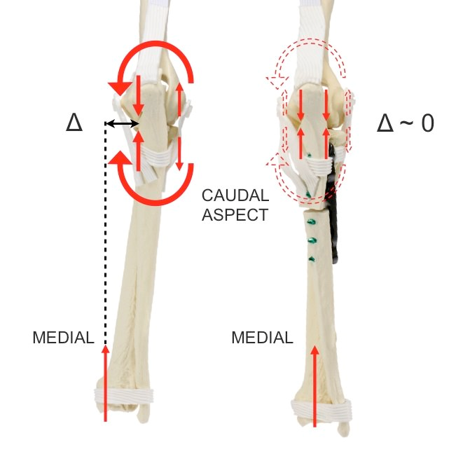Canine elbow dysplasia frequently results in loss of the articular surface cartilage (osteoarthritis) on the inside of the elbow joint. This is known as Medial Compartment Disease and can lead to long term elbow pain and lameness. The PAUL (Proximal Abducting Ulnar Osteotomy) procedure aims at unloading the medial compartment by aligning the limb and thus alleviating lameness, stiffness, and joint pain.
Multiple studies have investigated the biomechanical impact of PAUL and the effectiveness of this treatment.
The current study demonstrates that limb alignment after PAUL is more coaxial compared to the pre-operative situation.
Source:
Amadio A, Corriveau K, Norby B, Stephenson T, Sauders W
Effect of proximal abducting ulnar osteotomy (PAUL) on frontal plane thoracic limb alignment: An ex vivo canine study.
Veterinary Surgery. 2020;1–12 . DOI: 10.1111/vsu.13425
To determine the effect of PAUL using KYON’s PAUL plate on frontal plane thoracic limb alignment in standing and recumbent positions.
Ex vivo cadaveric study on canine thoracic limbs (n=15 limb pairs)
A limb press was used to obtain standing and recumbent caudocranial radiographs before and after PAUL. Foot lateralization and rotation were directly measured in standing position. Mechanical joint angles were determined using full limb radiographic montages and the center of rotation of angulation (CORA) method for pre-PAUL (Pre) and post-PAUL. ALPS PAUL-I plates with steps of 2mm and 3mm were compared.
Five of 12 limb alignment values in standing and recumbent positions were significantly different pre-PAUL and post-PAUL (standing position):
Chapter 15 of the book Canine Elbow Dysplasia discusses medial compartment disease and osteoarthritis. The PAUL procedure is discussed in detail including case selection, surgical technique, complication management, and functional outcomes.
Bruecker KA, Benjamino K, Vezzoni A, Walls C, Wendelburg KL, Follette CM, Déjardin LM, Guillou R.
Canine Elbow Dysplasia: Medial Compartment Disease and Osteoarthritis
Vet Clin North Am Small Anim Pract. 2021 Mar;51(2):475-515. doi: 10.1016/j.cvsm.2020.12.008. PMID: 33558016.
Inform veterinary professionals about case selection, surgical technique, complication management, and functional outcomes after PAUL.
Design:
PAUL-treated elbows were rechecked postoperatively with clinical measures and radiographs. Lameness was assessed subjectively on a 4-point grading scale.
Results:
Clinical results of 130 elbows suggest, that the rate of lameness grade 3 or grade 2 could be lowered from 92% (pre-operative) to 9% (6m post-operative). Improvement in gait from Pre-op to Post-op conditions has been demonstrated by both gait analysis and LOAD questionnaires completed by pet owners.
Conclusion:
Long-term results indicate that approximately 89% had full restoration of weight-bearing or were only occasionally lame. The risk of major complications after PAUL requiring surgical revision was small (4%) and easily resolved, mainly requiring plate removal. Long-term follow-up evaluations up to 9 years have not revealed excessive wear of the lateral compartment due to the intended mechanical axis shift and load redistribution from the medial compartment. The new PAUL plate, with 4.0-mm conical locking screws, showed an overall increased strength to better withstand the strong forces transmitted to the osteotomy by the triceps muscle, promoting quicker bone healing of the ulnar osteotomy.
With over 20 years in the market, we understand there is little room for mistakes when treating patients. We offer better solutions and best quality. Without compromise.
Learn more